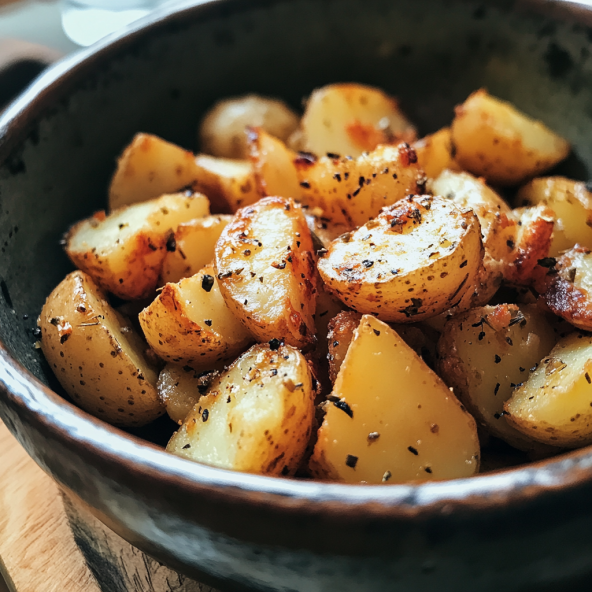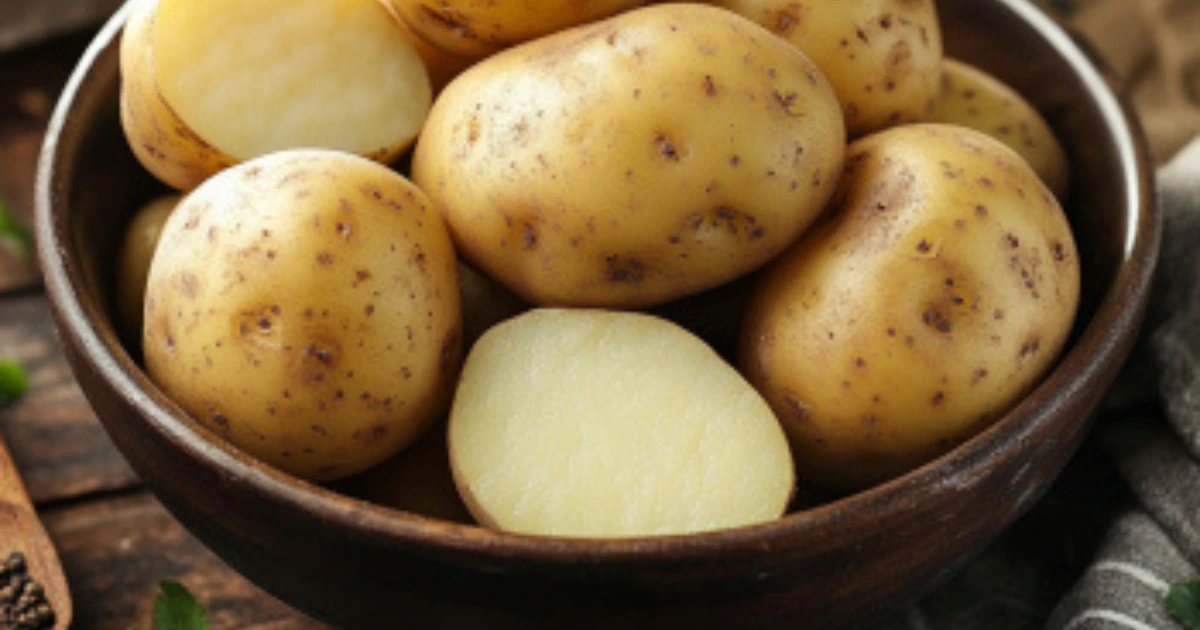When Should You Not Use Russet Potatoes?
Chefs widely recognize russet potatoes for their versatility in cooking, but you might want to avoid using them in certain situations. Their high starch content, rough skin, and dense texture make them perfect for specific dishes, but not every recipe suits their unique characteristics. Knowing when to choose a different type of potato can significantly impact the texture and flavor of your dish. Let’s explore the characteristics of russet potatoes and determine when you should opt for other varieties.
Table of Contents
Understanding the Characteristics
Russet potatoes are classified as starchy potatoes and are best known for their fluffy, dry texture when baked or mashed. Their thick brown skin is rough, and the flesh is typically pale yellow or white. Due to their high starch content, russets absorb flavors well and tend to break down when cooked for long periods. These characteristics make them ideal for baking, mashing, and frying.
However, their high starch levels also make them less suited for certain dishes where a firm texture is needed. Understanding these traits helps you know when russet potatoes might not be the right choice for your recipe.
Common Uses for Russet Potatoes
Russet potatoes are widely used in various dishes. The most common uses include:
- Baking: Russet potatoes are ideal for baking due to their large size and fluffy texture when cooked.
- Mashing: The starchy flesh makes russets perfect for achieving smooth and creamy mashed potatoes.
- Fries: Their high starch content helps russet potatoes develop a crisp exterior while remaining tender inside when fried.
These versatile uses highlight how russet potatoes excel in certain cooking methods. However, there are occasions when their fluffy texture and high starch content make them unsuitable for other types of dishes.
Situations Where Russet Potatoes Are Not Ideal
Low-Starch Recipes: When to Avoid Russet Potatoes
When preparing low-starch recipes, russet are not the best choice. Dishes such as potato salad or certain casseroles require a waxier variety of potato, such as red potatoes or Yukon Golds. These potatoes have a lower starch content, resulting in a firmer texture that holds up better in these types of recipes.
Using russet potatoes in low-starch recipes can cause them to break apart and become mushy. Therefore, opting for a waxy variety will ensure your dish maintains the desired consistency and texture.
When Texture Matters: Substituting Russets
If the texture of the potato is a crucial factor in your dish, russet potatoes may not always be the right choice. For recipes where a smooth, creamy texture is important without becoming overly mushy, such as iroasted potato dishes or sautéed potatoes, consider using Yukon Gold or new potatoes. These varieties have a waxier texture, providing a more cohesive and firm result.
Russets are excellent for baked potatoes or mashed dishes where fluffiness is key. However, for dishes that require more structure, a different variety will maintain the integrity of your recipe.
Why Russets Aren’t the Best for Salads
When preparing potato salad, russet potatoes should generally be avoided. Their high starch content causes them to break apart easily during cooking, leading to a mushy texture that doesn’t hold up well in cold salads. Instead, use waxy potatoes such as red potatoes or fingerling potatoes, which maintain their shape and texture better after boiling.
For the best potato salad, you want potatoes that can be cut into cubes without falling apart. Russet potatoes’ fluffy and soft texture doesn’t meet this requirement, making them unsuitable for dishes like potato salad that need a firmer, more cohesive potato bite.
Not Ideal for Stews or Soups
In stews or soups, russet may not be the best choice. While they will soften and break down easily, their texture doesn’t hold up well in long-simmering dishes. Russets tend to disintegrate into the broth, which can change the consistency of the soup or stew.
For soups or stews that require potatoes to hold their shape, consider using potatoes with a lower starch content, such as Yukon Gold or red potatoes. These varieties hold their shape better when cooked for extended periods and provide a more pleasant texture in soups.
Baking or Boiling with Thin-Skinned Potatoes Instead
Russet potatoes may not be the best option when you need potatoes with thin skin for certain recipes. For example, when you’re looking to bake or boil potatoes with the skin on and require a tender skin that doesn’t overpower the dish, consider using new potatoes or fingerling potatoes.
These potatoes have a thinner skin that becomes tender during cooking, unlike russets, whose thick skin can be more noticeable and tougher. If you want a delicate, thin-skinned potato, avoid russets and opt for a more suitable variety for those recipes.
Nutritional Considerations
High Starch Content and Its Implications
While russet potatoes are a great source of energy due to their high starch content, this can be a downside in certain dietary plans. High-starch foods can cause blood sugar spikes, which may be a concern for people with diabetes or those following a low-carb diet. The starchy nature of russet potatoes also makes them more calorie-dense than lower-starch varieties, so those watching their calorie intake might need to reconsider their portion sizes.
Despite these considerations, russet potatoes do offer a range of nutrients, including vitamin C, fiber, and potassium. However, the higher starch content means they may not be the best choice for those with specific dietary needs.

Dietary Restrictions: Low-Carb Diets
For individuals following low-carb or ketogenic diets, russet potatoes should generally be avoided. Their high carbohydrate content makes them unsuitable for these types of diets, which require low starch intake. While russet potatoes are an excellent source of energy, their carb-heavy composition may interfere with the goals of a low-carb eating plan.
Instead, low-carb dieters might want to opt for alternatives such as cauliflower or zucchini, which can mimic the texture of potatoes in certain dishes without the high carb count. As always, it’s important to consider your personal dietary goals and choose potato varieties that align with your needs.
Healthier Potato Options for Certain Needs
While russet potatoes are popular for many dishes, they may not always be the healthiest choice for every diet. They are high in starch and carbohydrates. Other potato varieties may be better suited for specific nutritional needs. For those watching their calorie intake or managing blood sugar, alternative potatoes can offer health benefits. They also provide the desired taste and texture. Let’s explore some healthier potato options that meet different dietary requirements.
Exploring Substitutes
Red Potatoes: Best for Salads and Soups
When preparing potato salads or soups, red potatoes are often a better choice than russets. They are waxier and have a lower starch content, which allows them to maintain their shape and texture when cooked. Red potatoes also offer a smooth, creamy consistency, making them perfect for dishes where you want potatoes to hold their form and not fall apart.
In addition, red potatoes are a good source of fiber, vitamins, and minerals. These nutrients, combined with their firm texture, make them a healthier alternative to russet potatoes in certain dishes, especially when texture and structure matter.
Yukon Golds: Versatile for Most Cooking Methods
Yukon Gold potatoes are another great substitute for russet , offering a balance of starch and waxiness. This makes them versatile for a wide variety of cooking methods, including baking, mashing, boiling, and roasting. They have a naturally creamy texture, making them perfect for mashed potatoes without being too fluffy or too firm.
In terms of health benefits, Yukon Golds have a slightly lower starch content compared to russets, which can be beneficial for those watching their carbohydrate intake. Additionally, their rich flavor and smooth texture can add a touch of gourmet appeal to various dishes.
Fingerlings for Roasting
If you enjoy roasting potatoes, fingerling potatoes are an excellent alternative to russets. These small, elongated potatoes have a firm texture that holds up well in high-heat cooking methods like roasting. Their thin skin becomes crispy and flavorful when roasted. This makes them a great choice for those seeking a healthier, nutrient-dense option.
Fingerlings pack antioxidants and have a lower glycemic index than russet potatoes. This makes them a better choice for people managing blood sugar levels or looking to reduce their overall carbohydrate intake. Their rich, earthy flavor adds depth to any roasted vegetable dish.
Sweet Potatoes as a Healthier Alternative
Sweet potatoes are often seen as a healthier alternative to russet potatoes. They have higher levels of fiber, vitamins, and antioxidants. Sweet potatoes are also an excellent source of vitamin A. With a lower glycemic index, they are a better choice for people with diabetes or those on low-carb diets. Additionally, sweet potatoes have a naturally sweeter taste. They can be prepared in many of the same ways as russets—baked, mashed, or roasted.
The high fiber content of sweet potatoes can help with digestion and provide a sense of fullness, making them a great choice for anyone looking to maintain a balanced, nutrient-rich diet.
Storage and Shelf Life Challenges
What Happens When Russet Potatoes Go Bad?
Improper storage or prolonged keeping of russet potatoes can cause them to spoil, resulting in changes to both texture and flavor. As they age, russets develop soft spots, wrinkles, or sprouts. If you notice these changes, avoid using them, as their texture will be compromised. Additionally, if russet potatoes turn green or develop a bitter taste, they may contain solanine, a harmful toxin that can be dangerous if consumed in large amounts.
It’s important to check russet potatoes regularly and discard any that show signs of rot or sprouting. Fresh russets will have firm, smooth skins and will be free from blemishes or soft spots.Check out how to prepare mashed potatoes from scratch for more tips.
How Storage Can Impact Quality
Proper storage is essential for maintaining the quality of russet potatoes. Store russets in a cool, dark, and dry place to preserve their texture and prevent sprouting. A pantry or cellar is ideal, as these areas keep russets fresh for several weeks. Avoid refrigerating russet , as the cold alters the starches. This can cause them to become sweet or change their texture.
If russet potatoes are exposed to excessive moisture, they can rot or develop mold, so it’s important to keep them in a well-ventilated area. Proper storage can significantly extend the shelf life and preserve the flavor of russet potatoes.
Recognizing When Not to Use Stored Russets
If you have stored russet for an extended period, it’s essential to inspect them carefully before use. If the potatoes show signs of sprouting or have developed a greenish tint on their skin, they should not be used. The green color indicates the presence of solanine, a toxic compound that can cause digestive distress if consumed in large amounts.
Additionally, if the russets have become soft, shriveled, or have any signs of mold, it’s best to discard them. Always ensure that your stored russet potatoes are firm, free from blemishes, and without any unpleasant odors before cooking with them.
FAQs
- Are russet potatoes good for weight loss?
While russet potatoes are relatively low in calories, they are high in starch, which can affect blood sugar levels. Eating them in moderation and paired with fiber-rich foods can make them a part of a balanced diet for weight loss.
- Can russet potatoes be stored in the refrigerator?
No, russet potatoes should not be stored in the refrigerator. The cold temperature can turn their starches into sugars, affecting their texture and flavor. Store them in a cool, dark, and dry place instead.
- What is the difference between russet potatoes and sweet potatoes?
Sweet potatoes are often considered a healthier alternative to russet potatoes due to their higher vitamin content, lower glycemic index, and higher fiber levels. Sweet potatoes are also naturally sweeter than russets.
- How can I tell if a russet potato is bad?
Signs of a bad russet include softness, wrinkles, sprouting, and a greenish tint. If a russet potato has any of these characteristics, it is best to discard it to avoid health risks.
Conclusion
Russet potatoes are a versatile and beloved ingredient in many kitchens, but there are times when they might not be the best choice. Understanding when not to use russet potatoes can help you make better culinary decisions based on texture, flavor, and nutritional needs. By exploring alternatives like red potatoes, Yukon Golds, fingerlings, and sweet potatoes, you can create healthier and more suitable dishes for various dietary requirements. Additionally, proper storage and understanding when russets have gone bad are key to ensuring that you’re using fresh, high-quality potatoes. Whether you’re looking for texture, flavor, or nutritional benefits, the right choice of potato can elevate your meal.

